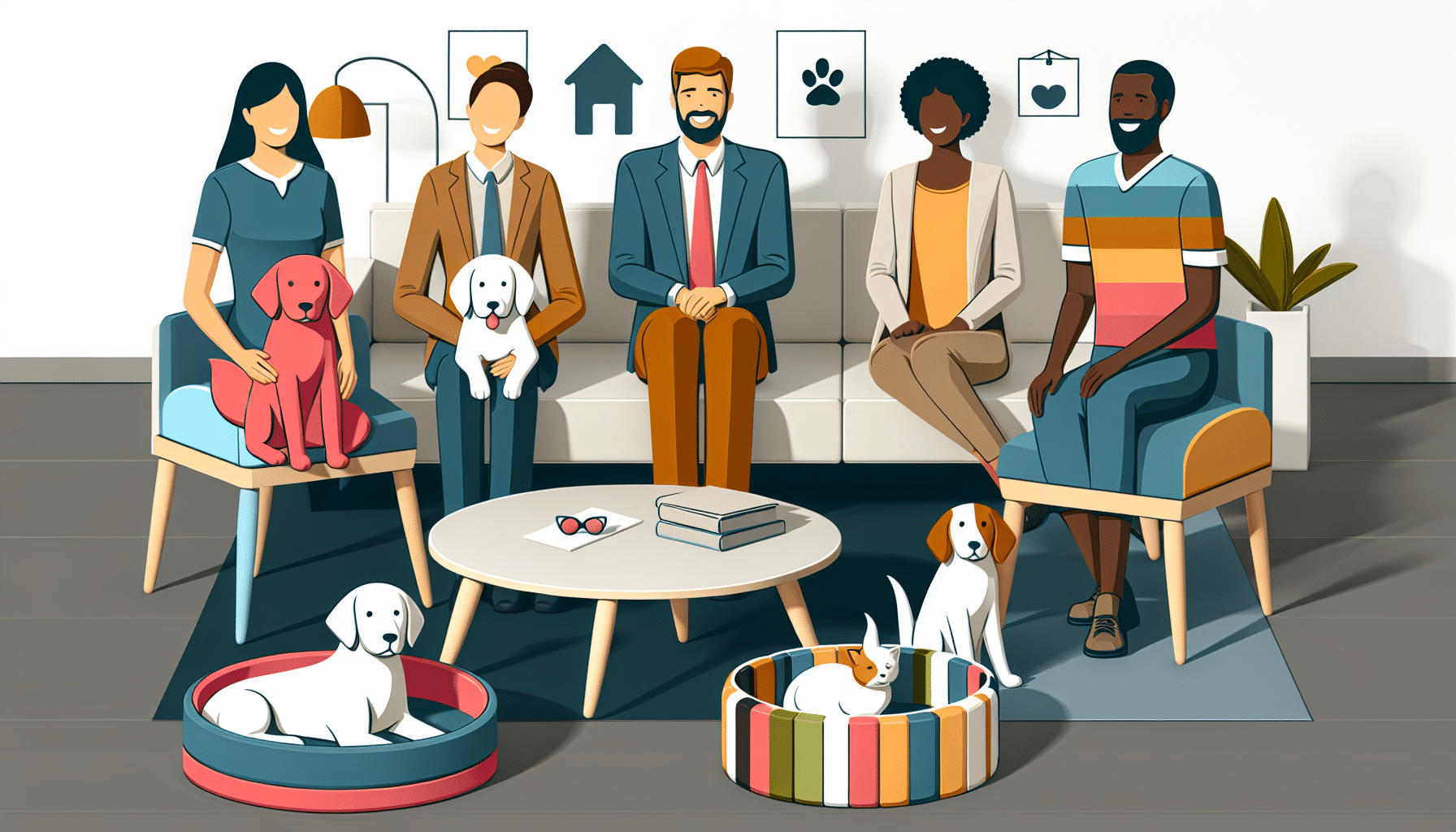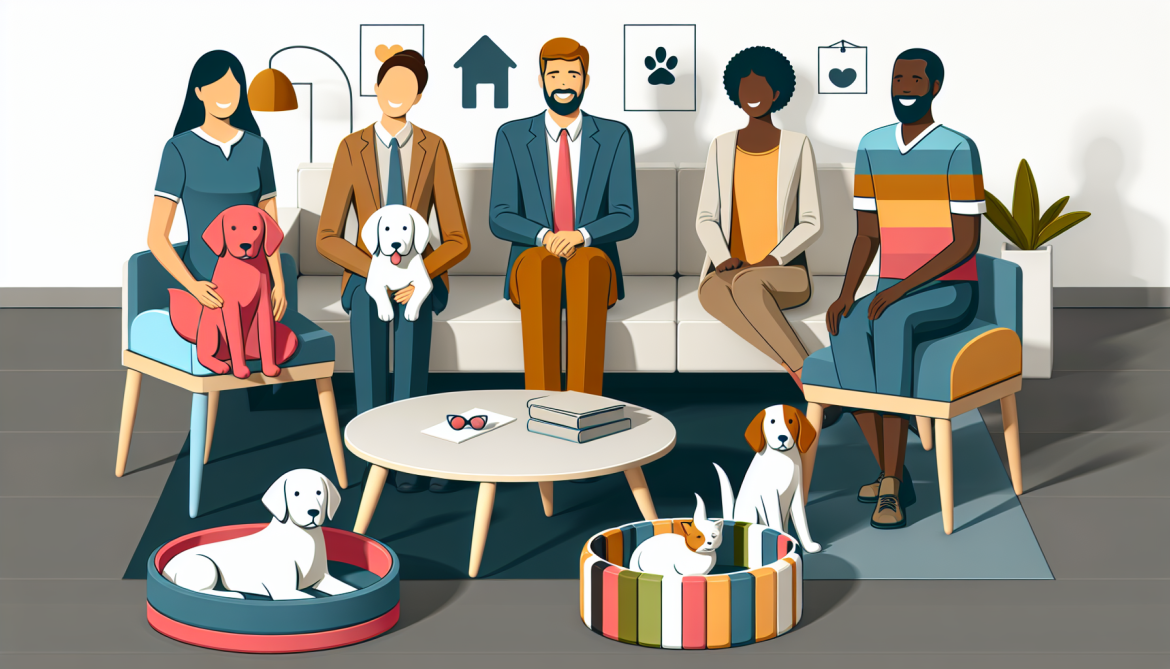Imagine a workplace where you can bring your furry best friend to work with you every day. Sounds too good to be true? Well, it doesn't have to be! In the article "Creating a Pet-Friendly Workplace: A Guide for Employers and Employees," we will explore the benefits of having pets in the workplace and provide practical tips on how both employers and employees can create a harmonious and pet-friendly environment. So whether you are a pet lover dreaming of having your four-legged companion by your side during working hours or an employer curious about the positive impact of pets in the workplace, this guide is for you. Get ready to discover a whole new level of happiness and productivity at work – with your furry friends in tow!

This image is property of images.pexels.com.
Benefits of a Pet-Friendly Workplace
Reduced Stress and Increased Productivity
One of the main benefits of having a pet-friendly workplace is the potential to reduce stress levels among employees. Numerous studies have shown that interacting with animals can lower blood pressure, reduce anxiety, and increase feelings of calmness and relaxation. When employees have the opportunity to bring their pets to work, they can take short breaks throughout the day to interact with their furry friends, which can help alleviate stress and improve overall well-being. This, in turn, can lead to increased productivity as employees feel more refreshed and focused on their work tasks.
Improved Employee Morale and Satisfaction
Allowing pets in the workplace can significantly improve employee morale and satisfaction. When employees are able to have their pets with them during the workday, it creates a positive and enjoyable environment. Pets provide companionship, emotional support, and can help boost the overall mood in the office. Having happy and content employees can contribute to a more positive work culture, increased job satisfaction, and a higher level of commitment to the company.
Enhanced Work-Home Balance
For many employees, the struggle to balance work and personal responsibilities can be a significant source of stress. Allowing pets in the workplace can help bridge the gap between home and work life, making it easier for employees to juggle their responsibilities. Instead of worrying about rushing home to walk their dog or check on their cat, employees can bring their pets to the office and have peace of mind knowing they are well taken care of. This enhanced work-home balance can lead to reduced stress and increased job satisfaction.
Boosted Workplace Communication and Collaboration
Pets have a unique way of bringing people together and fostering social connections. In a pet-friendly workplace, employees are more likely to interact and engage in conversations with their colleagues. This increased communication can lead to improved teamwork, collaboration, and problem-solving abilities. Moreover, pets can act as an icebreaker and conversation starter, helping to break down barriers between employees and creating a more inclusive and connected work environment.
Considerations for Employers
Developing a Pet Policy
Before implementing a pet-friendly policy, it is crucial for employers to develop a clear and comprehensive pet policy. This policy should outline the rules and guidelines for bringing pets to the workplace, including any restrictions on the types and sizes of pets allowed. It should also address issues such as vaccination requirements, behavior expectations, and liability concerns. By establishing a well-defined pet policy, employers can ensure a smooth and harmonious integration of pets into the workplace.
Addressing Allergies and Phobias
While many employees may enjoy having pets around, it is essential to consider potential allergies and phobias that some individuals may have. Employers should take measures to address these concerns by providing designated pet-free areas or implementing policies that require pets to be kept within specific areas. Additionally, educating employees about potential allergens and how to mitigate allergic reactions can help create a more inclusive and accommodating environment for all.
Setting Clear Guidelines and Expectations
To ensure a successful pet-friendly workplace, employers need to establish clear guidelines and expectations for both pet owners and non-pet owners. This includes setting boundaries on pet behavior, noise levels, and cleanliness. Communication is key, and regularly reminding employees of these guidelines and enforcing them consistently can help maintain a positive and respectful environment for everyone.
Creating Designated Pet Areas
Creating designated pet areas within the workplace is essential for maintaining a balance between allowing pets and meeting the needs of non-pet owners. These areas can include pet-friendly meeting rooms, outdoor spaces, or designated pet-free zones for employees who prefer to work in an environment without pets. By establishing designated areas, employers can foster a harmonious coexistence between all employees, including those who may not be comfortable around pets.
Ensuring Safety and Hygiene Measures
Employers must prioritize the safety and well-being of all employees, both human and animal. This includes ensuring that the workplace is free from hazards, such as toxic plants or substances that could harm pets. Employers should also promote good hygiene practices, such as regular handwashing and proper pet waste disposal, to maintain a clean and healthy environment for everyone.
Handling Potential Disruptions and Incidents
While having pets in the workplace can be a positive experience, there may be occasional disruptions or incidents that need to be addressed swiftly and professionally. Employers should have protocols in place to handle situations such as pet conflicts, accidents, or injuries. This can include providing resources for pet behavior training, establishing reporting procedures, and having a designated point person responsible for addressing any pet-related issues that may arise.
Offering Pet-Related Benefits
As part of creating a pet-friendly workplace, employers can explore offering pet-related benefits to employees. This can include perks such as discounted pet insurance, pet adoption assistance programs, or even on-site services such as grooming or veterinary care. By providing these benefits, employers not only enhance the overall employee experience but also demonstrate their commitment to supporting a healthy and balanced lifestyle for their workforce.

This image is property of images.pexels.com.
Benefits of Allowing Pets in the Workplace
Reduced Employee Absenteeism
Having a pet-friendly workplace can help reduce employee absenteeism. When employees are allowed to bring their pets to work, they may be more inclined to come to the office instead of taking a day off to attend to their pets' needs. This can result in a decrease in unscheduled absences and increase overall employee attendance and punctuality.
Increased Employee Retention
Creating a pet-friendly workplace can also contribute to increased employee retention. Employees who are given the opportunity to bring their pets to work are more likely to feel valued, appreciated, and satisfied in their roles. This increased job satisfaction can lead to higher levels of employee loyalty and a decreased turnover rate. Employees may be less likely to seek employment elsewhere if they are given the flexibility to have their pets by their side during the workday.
Attracting and Engaging Top Talent
In today's competitive job market, attracting and retaining top talent is a priority for employers. Offering a pet-friendly work environment can be a unique and attractive perk that sets a company apart from its competitors. Many job seekers, particularly those who are passionate about their pets, actively seek out employers who allow pets in the workplace. By embracing a pet-friendly culture, employers can appeal to a broader range of candidates and increase their chances of attracting highly skilled and dedicated professionals.
Positive Company Image and PR Opportunities
Allowing pets in the workplace can contribute to a positive company image and create opportunities for positive public relations (PR). Companies that prioritize the well-being and happiness of their employees, including their pets, are often seen as more progressive, compassionate, and employee-centric. This positive perception can enhance the company's brand reputation, attract positive media attention, and improve customer perception and loyalty.
Creating a Supportive and Inclusive Environment
By implementing a pet-friendly policy, employers can create a supportive and inclusive environment for their employees. This can contribute to a strong and cohesive company culture, where employees feel valued, respected, and able to bring their whole selves to work. Inclusion is not just about accommodating the needs of individual employees but also recognizing and honoring the important role that pets play in their lives. A pet-friendly workplace fosters a sense of belonging and can help build a tight-knit community within the organization.
Challenges and Solutions
Dealing with Pet Allergies
One of the most common challenges in a pet-friendly workplace is addressing pet allergies. Some employees may be allergic to pet dander, which can cause uncomfortable symptoms and potentially impact their overall health. To mitigate this issue, employers can create designated pet-free zones or implement air filtration systems to minimize allergens in the air. Furthermore, regular cleaning of common areas and furniture can help reduce the presence of allergens, making the environment more comfortable for all employees.
Managing Potential Conflicts Among Pets
Introducing multiple pets into a shared workspace can occasionally lead to conflicts or aggressive behavior. Employers should establish clear guidelines for pet owners, emphasizing the importance of properly socializing and training their pets. Encouraging employees to monitor their pets' behavior and promptly address any signs of aggression can help prevent conflicts. Additionally, providing resources for pet behavior training or organizing team-building activities that involve pets can promote positive social interactions and reduce the likelihood of conflicts.
Minimizing Distractions and Noise
Pets can bring joy and companionship, but they can also be a source of distraction and noise in the workplace. To minimize disruptions caused by pets, employers can establish guidelines on pet behavior and noise levels. This may include requiring pets to be kept on a leash, providing comforting areas for pets to rest during quiet work hours, or establishing quiet zones for employees who require minimal distractions. Effective communication and consistent enforcement of guidelines can help create a productive work environment for all.
Maintaining a Clean and Odor-Free Environment
Maintaining a clean and odor-free workplace is essential when allowing pets. Employers should provide readily accessible waste disposal areas for pets and supply cleaning products for employees to handle any accidents promptly. Regular cleaning and sanitizing of common areas, such as break rooms and restrooms, can help ensure a clean and pleasant environment for everyone. Employers may also consider implementing policies that require pets to be bathed regularly and for owners to maintain their pets' cleanliness.
Ensuring Compliance with Health and Safety Regulations
When implementing a pet-friendly workplace, it is crucial for employers to ensure compliance with health and safety regulations. This includes adhering to local regulations regarding animals in the workplace, maintaining proper vaccination records for pets, and addressing any potential health risks associated with animals. Employers should consult with legal experts and relevant authorities to ensure they are meeting all necessary requirements to provide a safe environment for both employees and pets.

This image is property of images.pexels.com.
Employee Responsibilities
Properly Training and Socializing Pets
As a responsible pet owner in a pet-friendly workplace, it is essential to properly train and socialize your pet. This helps ensure that they are well-behaved, obedient, and do not cause disruptions or conflicts with other animals or employees. Investing time and effort in training your pet can contribute to a positive and harmonious work environment for everyone.
Ensuring Pet Vaccinations and Health Check-ups
To keep pets, other animals, and employees safe, it is crucial to ensure that pets are up to date on vaccinations and receive regular health check-ups. Proper vaccination protocols can help prevent the spread of diseases and ensure the overall well-being of animals in the workplace. Regular veterinary visits are vital for monitoring and addressing any potential health concerns that may arise.
Keeping Pets Well-Behaved and Controlled
In a pet-friendly workplace, it is important to keep pets well-behaved and under control at all times. This includes preventing excessive barking, aggressive behavior, or any other conduct that may disrupt others or pose a risk. Pets should be kept on leashes or in designated areas as specified by the employer's pet policy. Being responsible and considerate pet owners can help maintain a positive and respectful environment for everyone.
Respecting Coworkers’ Preferences and Boundaries
While having pets in the workplace can be enjoyable for many, it is essential to respect the preferences and boundaries of coworkers. Some employees may have personal reasons for not being comfortable around pets or may have allergies or phobias. Being mindful of others' needs and maintaining open communication can help create a harmonious environment where everyone feels respected and understood.
Taking Responsibility for Any Accidents or Damage
As a pet owner in a pet-friendly workplace, it is important to take responsibility for any accidents or damage caused by your pet. Accidents happen, but promptly addressing and rectifying any damage or mess caused by your pet demonstrates accountability and consideration for others. This includes promptly reporting any incidents to supervisors, offering to cover expenses related to any damage caused, and taking necessary steps to prevent similar incidents in the future.
Implementing a Pet-Friendly Policy
Gaining Leadership Support
To successfully implement a pet-friendly policy, it is crucial to gain support from organizational leadership. This includes presenting a well-researched case for the benefits of a pet-friendly workplace and addressing any concerns or objections they may have. By demonstrating the potential positive impact on employee morale, productivity, and retention, employers can secure the necessary support to move forward with implementing the policy.
Surveying Employee Interest and Needs
Before finalizing a pet-friendly policy, it is important to survey employees to assess their interest and needs. This can be done through anonymous surveys or focus groups to gather feedback and understand the level of support for allowing pets in the workplace. By involving employees in the decision-making process, employers can tailor their policy to meet the specific needs and preferences of their workforce.
Developing and Communicating the Policy
Once a pet-friendly policy is established, it is essential to clearly communicate the guidelines, expectations, and benefits to all employees. This can be done through employee meetings, email communications, or posting the policy in common areas. Providing a comprehensive overview of the policy ensures that all employees are aware of their rights and responsibilities when it comes to bringing pets to work.
Preparing the Workplace
Preparing the workplace for a pet-friendly environment involves making necessary physical adjustments and providing essential amenities. This can include creating designated pet areas, installing pet waste disposal stations, providing pet beds or resting areas, and ensuring proper ventilation and cleanliness. Preparing the workplace ahead of time helps facilitate a smooth transition and sets the stage for a successful integration of pets into the work environment.
Providing Information and Resources
As part of the implementation process, employers should provide employees with information and resources to help them navigate the pet-friendly workplace. This can include educational materials on responsible pet ownership, training resources for behavior management, and information on local veterinary services and pet-related benefits. By offering these resources, employers support their employees in being responsible and informed pet owners.
Evaluating and Updating the Policy
Implementing a pet-friendly policy is an ongoing process that requires regular evaluation and updating. Employers should periodically assess the effectiveness of the policy and address any concerns or issues that may arise. This can be done through employee feedback surveys, monitoring the overall workplace environment, and adjusting the policy as needed to maintain a positive and productive work environment.

Introducing Pets to the Workplace
Gradual Introduction and Orientation
To ensure a smooth integration of pets into the workplace, a gradual introduction and orientation process is recommended. This involves allowing employees to bring their pets for short periods initially and gradually increasing the time spent in the office. This allows pets to acclimate to the new environment and helps identify and address any potential issues or concerns early on.
Trial Periods for Both Pets and Employees
Implementing trial periods for both pets and employees can help assess compatibility and ensure a successful pet-friendly environment. During these trial periods, employees can gauge their pets' behavior in the office setting and observe how they interact with other animals and employees. Likewise, employers can assess how the presence of pets impacts the overall work environment and address any unforeseen challenges.
Monitoring and Assessing Compatibility
Ongoing monitoring and assessment of compatibility between pets, employees, and the workplace environment are crucial. Regular observation of pet behavior, employee feedback, and addressing any evolving needs or concerns can help maintain a harmonious and productive pet-friendly workplace. Flexibility and open communication are key in ensuring that pets and employees coexist in a way that benefits everyone.
Addressing Behavioral Issues and Conflicts
In a pet-friendly workplace, occasional behavioral issues or conflicts may arise. It is important for employers to establish protocols for addressing these issues promptly and professionally. This may involve providing resources for pet behavior training, consulting with professionals, or offering support and guidance to owners in resolving any pet-related conflicts. By addressing these issues proactively, employers can maintain a positive and respectful work environment for all employees.
Establishing Rules for Visitors' Pets
While allowing employees to bring their pets to work can be beneficial, it is essential to establish rules and guidelines for allowing visitors' pets into the workplace. Visitors should be informed of the pet policy and should adhere to the same rules and expectations as employees. This ensures consistency in managing pets and provides a clear framework for maintaining a comfortable and safe environment.
Arranging Pet-Friendly Events
Organizing pet-friendly events can further enhance the sense of community and enjoyment in a pet-friendly workplace. This can include activities such as pet parades, adoption drives, or pet-themed contests. These events provide opportunities for employees to engage with their pets and bond with their colleagues in a fun and relaxed atmosphere. Pet-friendly events can contribute to a positive work culture and strengthen employee relationships.
Promoting a Positive Pet-Friendly Environment
Educating and Training Employees
Promoting a positive pet-friendly environment begins with educating and training employees on responsible pet ownership and the expectations outlined in the pet policy. Employers can offer workshops, seminars, or online resources to educate employees on pet behavior, health, and safety. By equipping employees with the necessary knowledge and skills, employers can foster a culture of responsible pet ownership and ensure a positive experience for all.
Encouraging Responsible Pet Ownership
Encouraging responsible pet ownership within the workplace is essential for maintaining a positive environment and ensuring the well-being of all pets. This can include providing guidance on pet care, nutrition, and exercise, as well as promoting the importance of regular veterinary care and vaccinations. By encouraging responsible ownership, employers can contribute to the happiness and health of their employees' pets.
Facilitating Pet-Related Activities
To promote a positive pet-friendly environment, employers can facilitate and encourage pet-related activities in the workplace. This may include organizing lunchtime walks or play sessions for pets, arranging pet-friendly exercise classes, or hosting pet-themed social events. These activities provide opportunities for employees to bond with their pets and colleagues while promoting a healthy work-life balance.
Fostering a Supportive Community
Creating a supportive community within a pet-friendly workplace is essential for employee well-being and satisfaction. Employers can foster a sense of community by organizing pet-owner support groups or social clubs, providing opportunities for employees to share advice and experiences related to pet ownership. By nurturing a supportive community, employers can strengthen the bond among employees and create an inclusive and engaging work environment.
Recognizing and Celebrating Pet Contributions
Recognizing and celebrating the contributions of pets in the workplace is an excellent way to promote a positive pet-friendly environment. Employers can acknowledge the positive impact pets have on employee well-being and productivity through employee recognition programs or regular appreciation events. Employees can share stories or testimonials about how their pets have contributed to their work-life balance or overall happiness, further highlighting the value of having pets in the workplace.

Overcoming Resistance and Concerns
Addressing Stereotypes and Myths
Resistance to implementing a pet-friendly policy can stem from stereotypes or myths surrounding pets in the workplace. Addressing these misconceptions by providing accurate information, sharing research on the benefits of pet-friendly workplaces, and showcasing real-life success stories can help dispel any negative perceptions. By challenging stereotypes, employers can demonstrate the validity and positive impact of allowing pets in the workplace.
Communicating the Benefits and Value
When faced with resistance to a pet-friendly policy, it is crucial to effectively communicate the benefits and value it brings to the workplace. Employers can emphasize the positive impact on employee well-being, stress reduction, increased productivity, and improved employee satisfaction. Sharing data, testimonials, or case studies can help illustrate the tangible benefits of embracing a pet-friendly culture.
Addressing Liability and Insurance Issues
One common concern surrounding pet-friendly workplaces is liability and insurance issues. Employers can address these concerns by consulting with legal and insurance professionals to ensure that proper measures are in place. This may include obtaining liability insurance that covers pet-related incidents, updating workplace policies to address liability, and requiring employees to sign liability waivers. By taking appropriate measures, employers can alleviate concerns and mitigate potential risks.
Negotiating with Landlords and Building Management
If the workplace is a rented space, obtaining permission from landlords or building management to allow pets may be necessary. Employers can negotiate with landlords or building management by presenting a well-thought-out proposal that addresses their concerns. This may include providing information on the benefits of a pet-friendly workplace, outlining the steps taken to mitigate potential risks, and offering to implement additional measures as requested by the landlord or building management.
Accommodating Individual Circumstances
It is important to acknowledge and accommodate employees with individual circumstances that may prevent them from participating in a pet-friendly workplace. This can include employees with allergies, phobias, or religious or cultural restrictions regarding animals. Offering alternatives, such as designated pet-free zones or flexible work arrangements, can help ensure that all employees feel comfortable and included in the workplace environment.
Resolving Conflicts and Issues Professionally
In any workplace, conflicts and issues may arise, including those related to pets. It is essential to handle these conflicts and issues professionally, adhering to established protocols and procedures. This may involve providing mediation or conflict resolution resources, encouraging open communication between employees, or seeking input from supervisors or human resources professionals. Resolving conflicts in a fair and equitable manner demonstrates the commitment to maintaining a positive work environment for all.
Promoting Pet Safety and Well-being
Providing Basic Facilities and Amenities
To promote the safety and well-being of pets in the workplace, employers should provide basic facilities and amenities. This may include designated areas for pets to rest, access to fresh water and food, and appropriate ventilation and temperature control to ensure their comfort. By providing these facilities, employers demonstrate their commitment to the health and well-being of pets in the workplace.
Ensuring Regular Breaks and Exercise
Pets require regular breaks and exercise to stay happy and healthy. Employers should encourage and accommodate employees in providing adequate breaks and opportunities for their pets to stretch their legs, play, or use the bathroom. This can be facilitated through designated areas for exercise or by allowing employees to take short breaks throughout the day to attend to their pets' needs. Regular exercise not only benefits pets but also contributes to a more relaxed and focused work environment.
Monitoring Temperature and Environmental Factors
Monitoring temperature and environmental factors is crucial to ensure the safety and well-being of pets in the workplace. Employers should ensure that the workplace is maintained at a comfortable temperature range and that pets are not exposed to extreme weather conditions. Additionally, employers should be mindful of potential hazards such as toxic plants or substances that could pose a threat to pets' health. Regular inspections and taking preventive measures can help create a safe environment for pets.
Creating Emergency and Evacuation Plans
In the event of an emergency or evacuation, it is important to have a pet-specific emergency plan in place. Employers should establish protocols for safely evacuating pets and designate designated areas where pets can be gathered during emergency situations. Providing necessary resources such as first aid kits and contact information for veterinary services can also contribute to the safety and well-being of pets in unexpected situations.
Offering Access to Veterinary Services
To prioritize the health and well-being of pets, employers can provide access to veterinary services within or near the workplace. This can include partnering with local veterinary clinics to offer discounts or on-site veterinary services for regular check-ups and vaccinations. By ensuring that pets receive necessary medical care, employers contribute to the overall health and happiness of their employees' pets.
Enforcing Responsible Pet Ownership
Enforcing responsible pet ownership is crucial for promoting the safety and well-being of pets in the workplace. Employers should establish clear guidelines and expectations for pet owners, including requirements for vaccination records, behavioral training, and cleanliness. Regular reminders and consistent enforcement of these guidelines help maintain a safe and healthy environment for pets and their owners alike.
In conclusion, creating a pet-friendly workplace can bring numerous benefits to both employers and employees. From reduced stress and increased productivity to improved employee morale and satisfaction, a pet-friendly environment can contribute to a positive work culture and attract top talent. However, it is essential for employers to consider various factors, such as developing policies, addressing allergies and phobias, and setting clear guidelines. By implementing strategies to overcome challenges and fostering a supportive and inclusive environment, employers can successfully introduce and maintain a pet-friendly workplace that promotes employee well-being and happiness.


